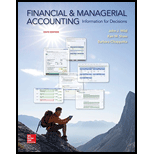
Concept explainers
Sales price variance:
Sales price variance can be defined as the differential value of the actual price of the products sold and the standardized value of the price of the products to be sold. It is an integral factor influencing the overall turnover of the business. Hence, any negative deviations if revealed by such variances should be fixed at the earliest.
Sales volume variance:
Sales volume variance can be defined as the differential value of number of units of the products actually sold and the projected number of units that were to be sold. The said value is multiplied by the expected price per unit. The company faces negative sales volume variance when the units actually sold are comparatively less than the projected units to be sold.
The sales price variance and the sales volume variance.
Want to see the full answer?
Check out a sample textbook solution
Chapter 21 Solutions
Financial and Managerial Accounting: Information for Decisions
- An income statement would not include O dividends paid. ○ discontinued operations. other revenue and gains. O income from operations.arrow_forwardAssume the following sales data for a company: 2026 $978000 2025 873200 2024 740000 If 2024 is the base year, what is the percentage increase in sales from 2024 to 2025? 18% 132% 118% ○ 32%arrow_forwardD company has an investment in trading securities of $139000. The fair value of the investment declined during the current year resulting in an unrealized loss of $6950. Assuming a 35% tax rate, the effect of this loss on other comprehensive income will be $90350 decrease. O no effect. O $139000 increase. ○ $48650 decrease.arrow_forward
- Sunland Corporation reported the following: Year 1 sales $720 Year 2 sales $840 Year 3 sales $900 What is the percentage to be assigned for Year 3 using horizontal analysis? ○ 117%. 80%. 125%. ○ 107%.arrow_forwardI want to this question answer for General accounting question not need ai solutionarrow_forwardAn income statement would not include O dividends paid. ○ discontinued operations. other revenue and gains. O income from operations.arrow_forward
- Ayayai Corporation reported net sales of $680000, $841100, and $911200 in the years 2024, 2025, and 2026, respectively. If 2024 is the base year, what percentage do 2026 sales represent of the base? 134% 108% 75% 34%arrow_forwardWhen a company compares each item in the asset section to total assets, the type of analysis being used is vertical analysis. differential analysis. O horizontal analysis. O trend analysis.arrow_forwardHello tutor please given General accounting question answer do fast and properly explain all answerarrow_forward
- provide correct solution of this general accounting questionarrow_forwardTitanium Industries used 6,200 labor hours (Driver) on Job #45. Total labor hours are 18,000. Assume Job #45 is the only job sold during the accounting period. What is the overhead applied in COGS if the total overhead applied is $126,000?arrow_forwardI need financial accounting question do fast answer and explanationarrow_forward

 AccountingAccountingISBN:9781337272094Author:WARREN, Carl S., Reeve, James M., Duchac, Jonathan E.Publisher:Cengage Learning,
AccountingAccountingISBN:9781337272094Author:WARREN, Carl S., Reeve, James M., Duchac, Jonathan E.Publisher:Cengage Learning, Accounting Information SystemsAccountingISBN:9781337619202Author:Hall, James A.Publisher:Cengage Learning,
Accounting Information SystemsAccountingISBN:9781337619202Author:Hall, James A.Publisher:Cengage Learning, Horngren's Cost Accounting: A Managerial Emphasis...AccountingISBN:9780134475585Author:Srikant M. Datar, Madhav V. RajanPublisher:PEARSON
Horngren's Cost Accounting: A Managerial Emphasis...AccountingISBN:9780134475585Author:Srikant M. Datar, Madhav V. RajanPublisher:PEARSON Intermediate AccountingAccountingISBN:9781259722660Author:J. David Spiceland, Mark W. Nelson, Wayne M ThomasPublisher:McGraw-Hill Education
Intermediate AccountingAccountingISBN:9781259722660Author:J. David Spiceland, Mark W. Nelson, Wayne M ThomasPublisher:McGraw-Hill Education Financial and Managerial AccountingAccountingISBN:9781259726705Author:John J Wild, Ken W. Shaw, Barbara Chiappetta Fundamental Accounting PrinciplesPublisher:McGraw-Hill Education
Financial and Managerial AccountingAccountingISBN:9781259726705Author:John J Wild, Ken W. Shaw, Barbara Chiappetta Fundamental Accounting PrinciplesPublisher:McGraw-Hill Education





